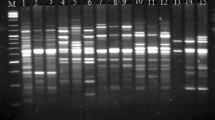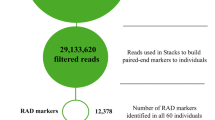Abstract
Random amplified polymorphic DNA (RAPD) technique was used to examine the genetic variability on an endangered Neotropical fish species, Brycon lundii, collected on two regions with distinct environmental conditions in the São Francisco River (Brazil), downstream from a hydroelectric station. Using decamer oligonucleotides as single primers in Polymerase Chain Reaction (PCR), genetic similarity index, mean allele frequency and mean heterozigosity were estimated, revealing variations between samples from the two regions. Moreover, a fragment of about 1200 base pairs was found in 100% of the examined animals collected at the region closer to the hydroelectric dam, while its frequency was much lower (27.3%) within the sample from the second collecting site, 30 km downstream from the dam, indicating a possible correlation between genetic variation and geographical area. A dendogram representing the relationships among genotypes was obtained, demonstrating at least two major clusters of animals. Based on the data, a model of population structuring in Brycon lundii is suggested. The described approach holds great promise for further analyses and gives support to biodiversity maintenance and recovery efforts of B. lundii.
Similar content being viewed by others
References
Ashbaugh, N. A., A. A. Echelle & A. F. Echelle, 1994. Genetic diversity in red river pupfish Cyprinodon-rubrofluviatilis (Atheriniformes, Cyprinodontidae) and its implications for the conservation genetics of the species. J. Fish Biol. 45: 291-302.
Avise, J. C., 1996. Introduction: the scope of conservation genetics. In Avise, J. C. & J. L. Hamrick (eds),Conservation Genetics: Case Histories from Nature. Chapman & Hall, New York: 1-9.
Bedore, A. & H. P. Godinho, 1999. Biologia do sêmen do matrinchã (Brycon lundii). XIII Encontro Brasileiro de Ictiologia: 507 pp.
Bielawski, J. P. & D. E. Pumo, 1997. Randomly amplified polymorphic DNA (RAPD) analysis of Atlantic Coast striped bass. Heredity 78: 32-40.
Blair, G. R., D. E. Rogers & T. P. Quinn, 1993. Variation in life history characteristics and morphology of sockeye salmon (Oncorhynchus nerka) in the Kvichak River system, Bristol Bay, Alaska. Trans. am. Fish Soc. 122: 550-559.
Braga, R. A., 1982. Depleção aparente do matrinxã, Brycon hilarii, em pesqueiros do Rio São Francisco, Brasil. Boletim Técnico DNOCS 40:175-180.
Cagigas, M. E., E. Vasquez, G. Blanco & J. A. Sánchez, 1999. Combined assessment of genetic variability in populations of brown trout (Salmo trutta L.) based on allozymes, microsatellites, and RAPD markers. Mol. Biotech. 1: 286-296.
Ceccarelli, P. S. & J. A. Senhorini, 1996. Brycon-Viabilização da produção de alevinos. Panorama da Aquicultura maio/junho: 10-11.
Dahle, G., M. Rahman & A. G. Eriksen, 1997. RAPD fingerprinting used for discriminating among three populations of Hilsa shad (Tenualosa ilisha). Fish. Res. 32: 263-269.
Diaz, M., J. Macpherson & B. Ely, 1998. Striped bass population subdivision within the Santee-Cooper system, South Carolina. Mol. mar. Biol. Biotech. 7: 191-196.
Dittman, A. H. & T. P. Quinn, 1996. Homing in Pacific salmon: mechanisms and ecological basis. J. exp. Biol. 199: 83-91.
Erlich, P. R., 1988. The loss of diversity: causes and consequences. In Biodiversity. National Academy Press, Washington, DC: 21-27.
Faria, C. A., 1994. Propagação artificial de piabanha (Brycon insignis) na seção de hidrobiologia e aqüicultura de Paraibuna-CESP. I Seminário Sobre Criação de Espécies do Gênero Brycon: 9-15.
Ferguson, A., J. B. Taggart, P. A. Prodöhl, O. McMeel, C. Thompson, C. Stone, P. McGinnity & R. A. Hynes, 1995. The applications of molecular markers to the study and conservation of fish populations with special reference to Salmo. J. Fish Biol. 47: 103-126.
Florian, F., T. Zerjal, F. Cattonaro, P. Edomi & G. Graziosi, 1995. DNA polymorphism in Dicentrarchus labrax L. Anim. Biol. 4: 19-24.
Gard, R., B. Drucker & R. Fagen, 1987. Differentiation of subpopulations of sockeye salmon (Oncorhynchus nerka), Karluk River system, Alaska. Can. spec. Publ. Fish. aquat. Sci. 96: 408-418.
Georges, M., A. S. Lequarre, M. Castelli, R. Hanset & G. Vassart, 1988. DNA fingerprinting in domestic animals using four different minisatellite probes. Cytogenet. Cell Genet. 47: 127-131.
Godoy, M. P., 1975. Peixes do Brasil. Subordem Characoidei. Bacia do Rio Mogi Guassu. Vol. II. Editora Franciscana, Piracicaba, SP: 397 pp.
Hartney, K. B., 1996. Site fidelity and homing behaviour of some kelp-bed fishes. J. Fish Biol. 49: 1062-1069.
Hodgson, J. R., D. E. Schindler & X. He, 1998. Homing tendency of three piscivorous fishes in a north temperate lake. Trans. am. Fish Soc. 127: 1078-1081.
Howes, G., 1982. Review of the genus Brycon (Teleostei, Characoidei). Bull. brasil. Mus. nat. Hist. 43: 1-47.
Jaccard, P., 1901. Étude comparative de la distribution florale dans une portion des Alpes et des Jura. Bull. Soc. vaudoise Sci. nat. 37: 547-579.
Jeffreys, A. J. & D. B. Morton, 1987. DNA fingerprints of dogs and cats. Anim. Genet. 18: 1.
Kirchhoff, S., J. M. Sevigny & C. M. Couillard, 1999. Genetic and meristic variations in the mummichog Fundulus heteroclitus, living in polluted and reference estuaries. Mar. evironm. Res. 47: 261-283.
Krebs, J. R. & N. B. Davies, 1996. An Introduction to Behavioural Ecology. Blackwell Scientific Publications, Oxford: 420 pp.
Kuusipalo, L., 1999. Genetic differentiation of endemic perch Lates stappersi (Centropomidae, Pisces) populations in Lake Tanganyika suggested by RAPD markers. Hydrobiologia 407: 141-148.
Lacy, R. C. & D. B. Lindenamyer, 1995. A simulation study of the impacts of population subdivision on the mountain brushtail possum Trichosurus caninus Ogilby (Phalangeridae: Marsupialia), in South-Eastern Australia. II. Loss of genetic variation within and between subpopulations. Biol. Conserv. 73: 131-142.
Lynch, M., 1996. A quantitative-genetic perspective on conservation issues. In Avise, J. C. & J. L. Hamrick (eds), Conservation Genetics: Case Histories from Nature. Chapman & Hall, New York: 471-501.
Lynch, M. & B. G. Milligan, 1994. Analysis of population genetic structure with RAPD markers. Mol. Ecol. 3: 91-99.
Meffe, G. K. & R. C. Vrijenhoek, 1988. Conservation genetics in the management of desert fishes. Conserv. Biol. 2:1-13.
Moritz, C., 1994. Defining ‘Evolutionary Significant Units’ for conservation. Trends Ecol. 9: 373-375.
Nunney, L. & K. A. Campbell, 1993. Assessing minimum viable population size: demography meets population genetics. Trends Ecol. Evol. 8: 234-239.
O'Brien, S. J., 1994. A role for molecular genetics in biological conservation. Proc. natl. Acad. Sci. U.S.A. 91: 5748-5755.
Quattro, J. M. & R. C. Vrijenhoek, 1989. Fitness differences among remnant populations of endangered Sonoran topminnow. Science 245: 976-978.
Quinn, T. P., A. P. Hendry & L. A. Wetzel, 1995. The influence of life history trade-offs and the size of incubation gravels on egg size variation in sockeye salmon (Oncorhynchus nerka). Oikos 74: 425-438.
Rogers, D. E., 1987. The regulation of age maturity in Wood River sockeye salmon (Oncorhynchus nerka). Can. spec. Publ. Fish. aquat. Sci. 96: 78-89.
Rohlf, F. J., 1993. NTSYS-PC: Numerical taxonomy and multivariate analysis system, version 1.80. Applied Biostatistics. Steauket, New York.
Sambrook, J., E. F. Fritsch & T. Maniatis, 1989. Molecular Cloning. A Laboratory Manual. Cold Spring Harbor Laboratory Press, Cold Spring Harbor, New York.
Sato, Y., M. O. T. D Miranda, N. Bazzoli & E. Rizzo, 1995. Impacto do reservatório de Três Marias sobre a piracema à jusante da barragem. XI Encontro Brasileiro de Ictiologia: 2.
Sneath, P. H. A. & R. R. Sokal, 1973. Numerical Taxonomy. WH Freeman (ed.), San Francisco, California.
Tallman, R. F., 1994. Homing, straying, and gene flow among seasonal separated populations of chum salmon (Oncorhynchusketa). Can. J. Fish. aquat. Sci. 51: 577-588.
Varnavskaya, N. V., C. C. Wood, R. J. Everett, R. L. Wilmot, V. S. Varnavsky, V. V. Midanaya & T. P. Quinn, 1994. Genetic differentiation of subpopulations of sockeye salmon (Oncorhynchus nerka) within lakes of Alaska, British Columbia, and Kamchatka, Russia. Can. J. Fish. aquat. Sci. 51: 147-157.
Yoshiyama, R.M., K. B. Gaylord, M. T. Philippart, T. R. Moore, J. R. Jordan, C. C. Coon, L. L. Schalk, C. J. Valpey & I. Tosques, 1992. Homing behavior and site fidelity in intertidal sculpins (Pisces, Cottidae). J. exp. mar. Biol. Ecol. 160: 115-130.
Welsh, J. & M. McClelland, 1990. Fingerprinting genomes using PCR with arbitrary primers. Nucl. Acids Res. 18: 7213-7218.
Williams, J. G. K., A. R. Kubelik, K. J. Livak, J. A. Rafalski & S. V. Tingey, 1990. DNA polymorphisms amplified by arbitrary primers are useful as genetic markers. Nucl. Acids Res. 18: 6531-6535.
Wilson, E. O., 1988. The current state of biological diversity. In Wilson, E. O. (ed.), Biodiversity. National Academy Press, Washington, DC: 3-18.
Wirgin, I. I., J. E. Stabile & J. R. Waldman, 1997. Molecular analysis in the conservation of sturgeons and paddlefish. Eviron. Biol. Fishes 48: 385-398.
Wright, S., 1969. The Theory of Gene Frequencies. In Evolution and the Genetics of Populations. University of Chicago Press, Chicago.
Author information
Authors and Affiliations
Rights and permissions
About this article
Cite this article
Pinto Wasko, A., Galetti, P.M. RAPD analysis in the Neotropical fish Brycon lundii: genetic diversity and its implications for the conservation of the species. Hydrobiologia 474, 131–137 (2002). https://doi.org/10.1023/A:1016569919615
Issue Date:
DOI: https://doi.org/10.1023/A:1016569919615




